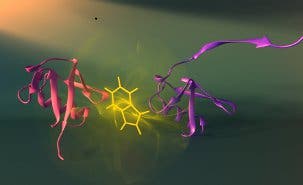Be it a bacteria or a fully complex being, say a human, all living, biological organisms undergo lighting fast protein structure reassembly in response to environmnetal stimuli. For instance, receptor proteins in the sinus are stimulated by various odor molecules, basically telling the organism that there’s food nearby or it’s in the vicinity of danger (sulphur, methane, noxious fumes). By studying these mechanisms, scientists can better understand these process. A great leap further in the field was achieved by researchers at the University of Montreal, who’ve managed to image how proteins self-assemble.

Here shown are two different assembly stages (purple and red) of the protein ubiquitin and the fluorescent probe used to visualize these stage (tryptophan: see yellow). Credit: Peter Allen.
Understanding and mapping these process helps pave a broader, more plastic picture of how organisms function from a molecular assembly mechanism point of view, but maybe most importantly aids in pinpointing assembly errors. Both Alzheimer’s and Parkinson’s, two of the most devastating neural degenerative disease currently plaguing mankind, are caused by errors in molecular assembly. According to Professor Stephen Michnick, the research is expected to help bioengineers design new molecular machines for nanotechnology applications which might fight these diseases.
“In order to survive, all creatures, from bacteria to humans, monitor and transform their environments using small protein nanomachines made of thousands of atoms,” explained Michnick.
Proteins are composed of linear structural chains of amino acids, which have the capability to self assemble at the rate of thousandth of a second into a nanomachine by virtue of millions of years of evolution. Determining how these proteins self-assemble is a crucial goal in biotechnology at the moment, however, this extremely fast assembly velocity, as well as the numerous possible combinations, makes it extremely difficult.
“One of the main challenges for biochemists is to understand how these linear chains assemble into their correct structure given an astronomically large number of other possible forms,” Michnick said.
Researcher Dr. Alexis Vallée-Bélisle expressed similar sentiments.
“To understand how a protein goes from a linear chain to a unique assembled structure, we need to capture snapshots of its shape at each stage of assembly,” Vallée-Bélisle noted.
The researchers sought to overcome these setbacks, and successfully established a new method for visualizing the process of protein assembly by attaching fluorescent probes at all points on the linear protein chain.
“The problem is that each step exists for a fleetingly short time and no available technique enables us to obtain precise structural information on these states within such a small time frame. We developed a strategy to monitor protein assembly by integrating fluorescent probes throughout the linear protein chain so that we could detect the structure of each stage of protein assembly, step by step to its final structure.”
However, Vallée-Bélisle emphasized that the protein assembly process “is not the end of its journey,” as a protein can change, via chemical modifications or with age, to take on different forms and functions.
“Understanding how a protein goes from being one thing to becoming another is the first step towards understanding and designing protein nanomachines for biotechnologies such as medical and environmental diagnostic sensors, drug synthesis of delivery,” he added.
The research is funded by Le fond de recherché du Québec, Nature et Technologie and the Natural Sciences and Engineering Research Council of Canada. The findings were published in the journal Nature Structural & Molecular Biology.
source: U Montreal.









